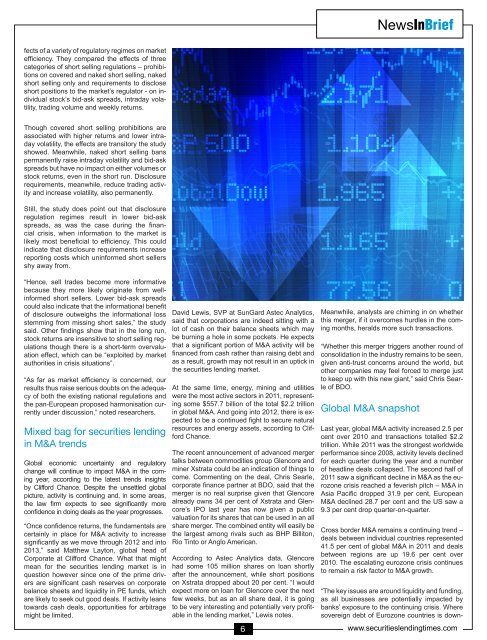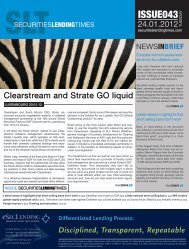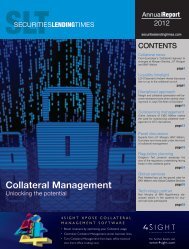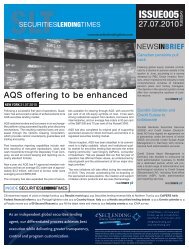ISSUE045 - Securities Lending Times
ISSUE045 - Securities Lending Times
ISSUE045 - Securities Lending Times
- No tags were found...
Create successful ePaper yourself
Turn your PDF publications into a flip-book with our unique Google optimized e-Paper software.
NewsInBrieffects of a variety of regulatory regimes on marketefficiency. They compared the effects of threecategories of short selling regulations – prohibitionson covered and naked short selling, nakedshort selling only and requirements to discloseshort positions to the market’s regulator - on individualstock’s bid-ask spreads, intraday volatility,trading volume and weekly returns.Though covered short selling prohibitions areassociated with higher returns and lower intradayvolatility, the effects are transitory the studyshowed. Meanwhile, naked short selling banspermanently raise intraday volatility and bid-askspreads but have no impact on either volumes orstock returns, even in the short run. Disclosurerequirements, meanwhile, reduce trading activityand increase volatility, also permanently.Still, the study does point out that disclosureregulation regimes result in lower bid-askspreads, as was the case during the financialcrisis, when information to the market islikely most beneficial to efficiency. This couldindicate that disclosure requirements increasereporting costs which uninformed short sellersshy away from.“Hence, sell trades become more informativebecause they more likely originate from wellinformedshort sellers. Lower bid-ask spreadscould also indicate that the informational benefitof disclosure outweighs the informational lossstemming from missing short sales,” the studysaid. Other findings show that in the long run,stock returns are insensitive to short selling regulationsthough there is a short-term overvaluationeffect, which can be “exploited by marketauthorities in crisis situations”.“As far as market efficiency is concerned, ourresults thus raise serious doubts on the adequacyof both the existing national regulations andthe pan-European proposed harmonisation currentlyunder discussion,” noted researchers.Mixed bag for securities lendingin M&A trendsGlobal economic uncertainty and regulatorychange will continue to impact M&A in the comingyear, according to the latest trends insightsby Clifford Chance. Despite the unsettled globalpicture, activity is continuing and, in some areas,the law firm expects to see significantly moreconfidence in doing deals as the year progresses.“Once confidence returns, the fundamentals arecertainly in place for M&A activity to increasesignificantly as we move through 2012 and into2013,” said Matthew Layton, global head ofCorporate at Clifford Chance. What that mightmean for the securities lending market is inquestion however since one of the prime driversare significant cash reserves on corporatebalance sheets and liquidity in PE funds, whichare likely to seek out good deals. If activity leanstowards cash deals, opportunities for arbitragemight be limited.David Lewis, SVP at SunGard Astec Analytics,said that corporations are indeed sitting with alot of cash on their balance sheets which maybe burning a hole in some pockets. He expectsthat a significant portion of M&A activity will befinanced from cash rather than raising debt andas a result, growth may not result in an uptick inthe securities lending market.At the same time, energy, mining and utilitieswere the most active sectors in 2011, representingsome $557.7 billion of the total $2.2 trillionin global M&A. And going into 2012, there is expectedto be a continued fight to secure naturalresources and energy assets, according to CliffordChance.The recent announcement of advanced mergertalks between commodities group Glencore andminer Xstrata could be an indication of things tocome. Commenting on the deal, Chris Searle,corporate finance partner at BDO, said that themerger is no real surprise given that Glencorealready owns 34 per cent of Xstrata and Glencore’sIPO last year has now given a publicvaluation for its shares that can be used in an allshare merger. The combined entity will easily bethe largest among rivals such as BHP Billiton,Rio Tinto or Anglo American.According to Astec Analytics data, Glencorehad some 105 million shares on loan shortlyafter the announcement, while short positionson Xstrata dropped about 20 per cent. “I wouldexpect more on loan for Glencore over the nextfew weeks, but as an all share deal, it is goingto be very interesting and potentially very profitablein the lending market,” Lewis notes.6Meanwhile, analysts are chiming in on whetherthis merger, if it overcomes hurdles in the comingmonths, heralds more such transactions.“Whether this merger triggers another round ofconsolidation in the industry remains to be seen,given anti-trust concerns around the world, butother companies may feel forced to merge justto keep up with this new giant,” said Chris Searleof BDO.Global M&A snapshotLast year, global M&A activity increased 2.5 percent over 2010 and transactions totalled $2.2trillion. While 2011 was the strongest worldwideperformance since 2008, activity levels declinedfor each quarter during the year and a numberof headline deals collapsed. The second half of2011 saw a significant decline in M&A as the eurozonecrisis reached a feverish pitch – M&A inAsia Pacific dropped 31.9 per cent, EuropeanM&A declined 28.7 per cent and the US saw a9.3 per cent drop quarter-on-quarter.Cross border M&A remains a continuing trend –deals between individual countries represented41.5 per cent of global M&A in 2011 and dealsbetween regions are up 19.6 per cent over2010. The escalating eurozone crisis continuesto remain a risk factor to M&A growth.“The key issues are around liquidity and funding,as all businesses are potentially impacted bybanks’ exposure to the continuing crisis. Wheresovereign debt of Eurozone countries is downwww.securitieslendingtimes.com












